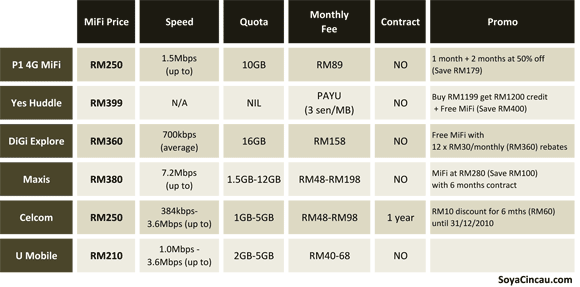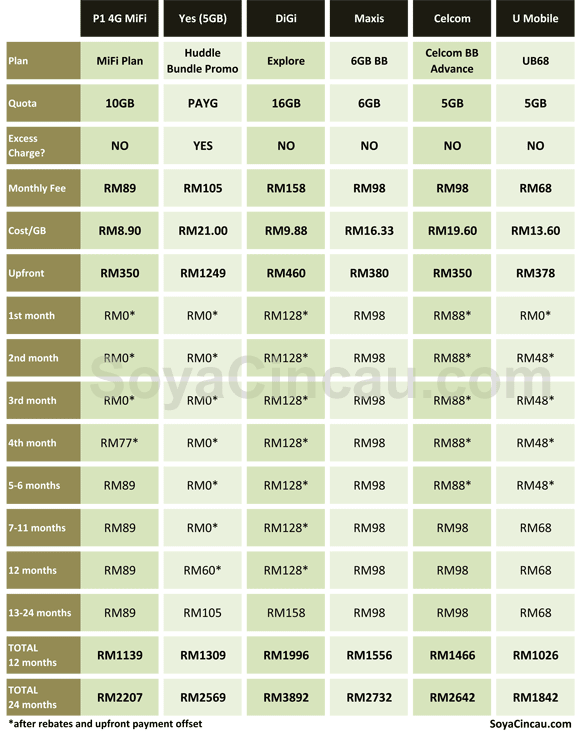Yesterday P1 launched the MF230 its very own MiFi device making it the sixth operator to offer portable hotspot in Malaysia, despite being the first to indicate that it will be launching a MiFi.
So now that we have a selection of MiFi from virtually all of the mobile operators in Malaysia, 3G and 4G, the inevitable question in consumers’ minds would be, which operator provides the best offering? Well we’ve taken out all the guesswork for you and compare all the MiFi plans available in the market based on device pricing and subscription costs over 12 and 24 months. Going a step further, we’ve also taken consideration of each operators respective bundled rebates, discounts and upfront costs.

P1 4G
As an introductory offer, P1 is the most affordable entrant (this is of course without taking into account the cost of the iPad which you need to purchase to be able to get the MF230) with a generous amount of data quota thrown in at 10GB/month. The device is priced at RM250 and requires RM100 up front which will be rebated back into your subsequent bills. To sweeten the deal, the first month subscription is free and an additional 50% off for the second and third month subscription thrown in for good measure. Taking into account the RM100 upfront, you have more than enough credit in your account for continuous service until the 4th month. In addition, P1 has also waived its RM60 account activation fee .
More info on the P1 4G MiFi plan here.
Yes 4G
In terms of technology, Yes is P1 closest competitor, as both run on WiMAX but both approach the market differently whereas P1 uses a post-paid payment model, Yes uses something of a hybrid post-paid, prepaid model where you purchase credit in advance but there is a minimum monthly usage amount of RM30/month. It is also worth pointing out that, our extensive tests reveals that P1 is currently the only wireless operator that does not support mobile use. Meaning you can’t use P1 while traveling in a car for example.
Yes offers their Huddle standalone at RM399. You can also get the Huddle for free if you purchase RM1199 worth of Yes credit in one receipt. You can opt to pay this amount over a period of 24 months interest free with your credit card. Yes charges are based on pay-as-you-go rate of 9sen/3MB before rebates. That’s about RM30/GB or as low as RM21/GB if you exceed 4GB in a month.
You can read about how Yes rebates are calculated here. As mentioned before, for data use alone Yes is good for light to moderate use but it can get very costly for heavy users who use more than 6GB/month. But on the other hand, you have to take into consideration that with the same Yes account, you can make phone calls and send SMS without extra monthly add-ons. Also, there is a RM50 activation fee but you can offset this fee with the Yes credit purchased.
In terms of the device itself, we have to point out that Yes’ Huddle can only connect up to four devices at any one time while most of the other MiFis can connect up to five.
More information on the Yes MiFi package here.
DiGi
DiGi’s MiFi offering comes in the form of the DiGi Explore 16GB with MiFi package where you purchase the device outright at RM360 and the cost of device is rebated back into your bill at RM30/month for 12 months. There’s no contract, however if you decide to exit early (as in terminate the service before the 12 months are up), the rebate amount will be forfeited. So essentially, there is some kind of a lock in.
Monthly, the DiGi plan cost RM158 but with the rebate its RM128 for the first 12 months. The only issue we have with the DiGi plan is that it doesn’t cater for light and moderate users. There is no option for subscribers who use between 3GB to 6GB a month for example. Your only option is a 16GB package that cost RM158 a month. If you don’t use that much then you end up paying for data that you don’t actually use.
At first glance, this might look different from the Yes offering but it is essentially the same thing. Both offer rebate equivalent to the cost of the device. In DiGi’s case the rebate is spread over 12 months. In the case with Yes, the rebate is offered back instantaneously so you are free to use the rebate amount right from the start.
For more on DiGi MiFi click here.
Maxis
For Maxis, the MiFi device is priced at RM380 if you purchase it outright but if you opt to go ride on a 6-months contract with any of Maxis’ data plan then the cost is RM280. In the market, Maxis offers the most flexibility as customers are able to choose the best plan data plan that suits them. There is a selection of broadband plans ranging from 1.5GB data quota all the way up to 12GB. Whether you’re a light user or a heavy user, there’s a selection of plans you can choose from. Though, do note that for the Maxis Broadband plans, there is charge a one time non-refundable activation fee of RM100.
Click here for details on the Maxis MiFi plan.
Celcom
Celcom recently introduced its MiFi offering in their Celcom Sale promotion. This is the only MiFi plan with a fixed contract of 12 months. With Celcom, the device costs RM250 and you get a selection of three broadband plans to choose from with data quotas between 1GB to 5GB options. Currently, Celcom is running a promotion where you get RM10 off the monthly subscription amount for the first 6 months if you subscribe before December 31, 2010. Just like Maxis, they also charge a one-time non-refundable RM100 activation fee.
U Mobile
U Mobile’s MiFi is the cheapest in the market at RM210 outright. In addition to that, there is no contract but but you will have to commit to an upfront payment of RM168, all of which will be rebated back to your bill over several months. Specifically, RM68 will be rebated back into your bill on the first month and the remaining RM100 will be rebated over 5 months (RM20/month from the second to sixth month).
In terms of plans, there are two options from U Mobile, the UB40 with 2GB quota at 1.0Mbps download speed or the higher UB68 with 5GB quota and speeds up to 3.6Mbps. For the UB40, if you exceed 2GB data you will be charged RM10/MB additional so choose your plan carefully. As it might look like opting for the UB40 plan is cheaper but if you’re consistently using more than 2GB, it could be more expensive than the UB68 plan.
We feel like the U Mobile UB68 plan is virtually identical to the 3GB broadband plan from Maxis.
For more info on U Mobile MiFi click here.
MiFi Devices
In terms of devices all of the 3G operators have opted for variant of the Huawei E5832 MiFi with Celcom and U Mobile offering a more recent E585 that offers a more details LCD display rather than LED lighted icons on the older models.
Amongst the 4G operators, P1 opted to go in house with its very own MF230 MiFi developed by parent company Green Packet while Yes went with a device developed by Infomark.
In terms of performance, we have not tested any one of these devices and on paper there is very little to separate except for the Huddle. It can only connect four device simultaneously as compared to the other devices that can connect up to five devices at one time.
How much do you pay?
So how much does it cost to own a MiFi device with the operators? We calculated and listed out the cost and quota for each operator. Assuming that the typical MiFi user will naturally share his connection with other users or devices, we picked 5GB as the typical usage scenario of MiFi usage. So please note that this may not be applicable for everyone.

From the table above, P1 is the most affordable considering its generous 10GB quota at RM1,139 for a year based on our 5GB/month usage scenario. If calculating cost per GB, P1 is also the most affordable at only RM8.90/GB. However the cheapest entry cost to own with 5GB usage still goes to U Mobile with overall ownership cost of RM1,026 for a year with the most affordable MiFi in the market.
Among the six, DiGi is the most expensive to own and run for casual users but if you do use up to 16GB, this is actually the second cheapest in terms of cost per GB at RM9.88.
Of course there are other factors to consider such as achievable network performance, network coverage and device performance. You’ll have to also take into account your typical download quota requirements before choosing a plan. We aim to provide a rough reference for comparison and if you plan to get one, we suggest you calculate based on your usage and service availability.
If you spot any errors on the tables above, please drop us a note at the comments below.
Do check out our previous Broadband Price comparison in Malaysia post.






